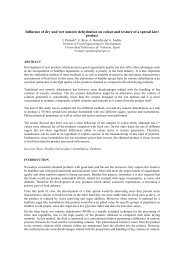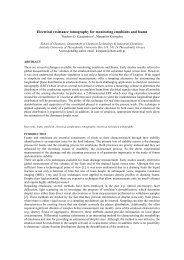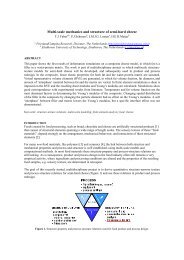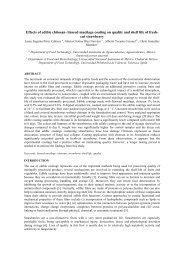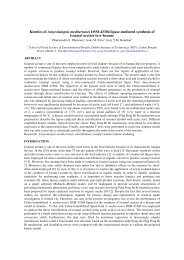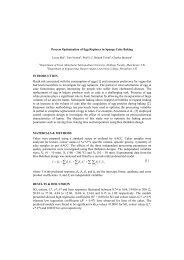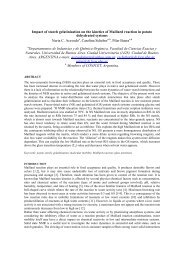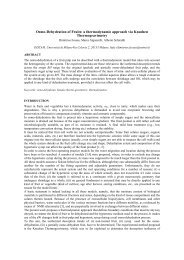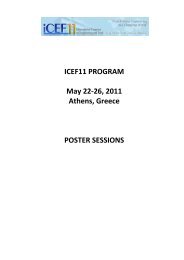The antioxidant properties of honey beer
The antioxidant properties of honey beer
The antioxidant properties of honey beer
Create successful ePaper yourself
Turn your PDF publications into a flip-book with our unique Google optimized e-Paper software.
<strong>The</strong> <strong>antioxidant</strong> <strong>properties</strong> <strong>of</strong> <strong>honey</strong> <strong>beer</strong><br />
Ana Kalušević, Gordana Uzelac, Mile Veljović, Saša Despotović, Mirjana Milutinović,<br />
Ida Leskošek-Čukalović, Viktor Nedović<br />
Department <strong>of</strong> Food Technology and Biochemistry, Faculty <strong>of</strong> Agriculture, University <strong>of</strong> Belgrade,<br />
Nemanjina 6, 11080 Belgrade-Zemun, Serbia<br />
(anakalusevic@gmail.com)<br />
ABSTRACT<br />
For centuries, <strong>honey</strong> represented a universal sweetener and it has been used for a variety <strong>of</strong> alcoholic<br />
beverages, including <strong>honey</strong> <strong>beer</strong>. In food industry, especially among the brewers, using <strong>of</strong> natural ingredients<br />
is increasingly growing demand. Honey is a natural, sweet and viscous substance, which is characterized by<br />
highly valued nutritional and physiological <strong>properties</strong>. Beer is one <strong>of</strong> the most popular beverage in the world<br />
with evident positive effects on the overall health condition. It can be used as a base for developing a variety<br />
<strong>of</strong> products with specific physiological activity. Honey is standing out as one <strong>of</strong> the possible sources <strong>of</strong> active<br />
ingredients for that purpose. Significant pharmacological activity <strong>of</strong> phenolic compounds in <strong>honey</strong>, even in<br />
such small quantities, can contribute to the <strong>antioxidant</strong> potential <strong>of</strong> <strong>beer</strong>.<br />
<strong>The</strong> aim <strong>of</strong> this study was to investigate the influence <strong>of</strong> different types and content <strong>of</strong> <strong>honey</strong> on the<br />
<strong>antioxidant</strong> <strong>properties</strong> <strong>of</strong> <strong>beer</strong>.<br />
<strong>The</strong> industrial wort, bottom-fermenting yeast strain and two types <strong>of</strong> mon<strong>of</strong>loral <strong>honey</strong> (sunflower and linden<br />
<strong>honey</strong>) were used. Honey was added in wort immediately before fermentation in a concentration <strong>of</strong> 5 and<br />
10%. Honey <strong>beer</strong>s were analyzed for their total polyphenol content by two methods - by the Folin-Ciocalteu<br />
reagent method and by EBC method. <strong>The</strong>ir antiradical capacity was tested by DPPH method and FRAP<br />
assay.<br />
<strong>The</strong> results indicate that obtained <strong>beer</strong>s have higher polyphenol content and <strong>antioxidant</strong> potential than control<br />
<strong>beer</strong>. <strong>The</strong> most significant results are achieved with 10% <strong>of</strong> linden <strong>honey</strong>.<br />
Combination <strong>of</strong> these two fully natural products, <strong>honey</strong> and <strong>beer</strong>, are giving the product that is characterized<br />
with, not only with higher <strong>antioxidant</strong> potential, but with satisfactory sensory <strong>properties</strong> as well.<br />
Keywords: <strong>honey</strong>; <strong>beer</strong>; <strong>antioxidant</strong> <strong>properties</strong>; polyphenol content.<br />
INTRODUCTION<br />
Beer is a worldwide traditional natural drink which has a higher nutritional value than other alcoholic<br />
beverages. Raw materials for <strong>beer</strong> production are water, yeast, malt, non-malted cereals and hop. It contains<br />
minerals and vitamins, proteins, organic acids and <strong>antioxidant</strong> compounds, such as polyphenols. Among<br />
these <strong>antioxidant</strong>s, phenolic compounds are <strong>of</strong> particular interest to brewers because they play a key role in<br />
the brewing process by delaying, retarding or preventing oxidation processes [1]. Phenolic compounds<br />
identified in <strong>beer</strong> include flavonoids, phenolic acids, proanthocyanidins, tannins, and amino phenolic<br />
compounds [2, 3]. All <strong>of</strong> them have been reported to possess antiradical and <strong>antioxidant</strong> <strong>properties</strong> as well as<br />
other biological effects [4].<br />
<strong>The</strong>re is a growing demand <strong>of</strong> natural products in human diet, due to increased consumer perception <strong>of</strong><br />
natural nutraceuticals in recent years and the possible negative effects <strong>of</strong> synthetic food additives on human<br />
health.<br />
Honey is a natural food product well known for its high nutritional and prophylactic-medicinal value. It has a<br />
wide range <strong>of</strong> different constituents, including polyphenols, with significantly <strong>antioxidant</strong> <strong>properties</strong>. It has<br />
been demonstrated that <strong>honey</strong>, measured by the assay <strong>of</strong> absorbance capacity <strong>of</strong> oxygen radicals on a freshweight<br />
basis shows similar <strong>antioxidant</strong> capacity to many fruits and vegetables on a fresh-weight basis, as<br />
measured by the assay <strong>of</strong> absorbance capacity <strong>of</strong> oxygen radicals [5].<br />
<strong>The</strong> awareness <strong>of</strong> the therapeutic potential <strong>of</strong> <strong>honey</strong> is gradually growing and scientific evidences <strong>of</strong> its<br />
effectiveness in several experimental and clinical conditions are beginning to emerge.<br />
<strong>The</strong> composition <strong>of</strong> active components in <strong>honey</strong> depends on various factors: floral source used to collect<br />
nectar seasonal and environmental factors, particularly plant bio and chemotype, climatic conditions, as well<br />
as its processing [5,6,7].<br />
<strong>The</strong> objective <strong>of</strong> this study was to examine and compare phenolic pr<strong>of</strong>iles and <strong>antioxidant</strong> activities <strong>of</strong> two<br />
different types <strong>of</strong> <strong>honey</strong> <strong>beer</strong>s.
MATERIALS & METHODS<br />
<strong>The</strong> wort and bottom-fermenting yeast used in this study were obtained from a local brewery. Two types <strong>of</strong><br />
<strong>honey</strong>, sunflower and linden <strong>honey</strong>, were purchased from local market. Control <strong>beer</strong> was produced by<br />
fermenting pure wort without adding <strong>of</strong> <strong>honey</strong>.<br />
Gallic acid, Folin-Ciocalteu’s phenol reagent, ammonium hydroxide, hydrochloric acid, sodium acetate<br />
trihydrate, glacial acetic acid, ammonium ferric citrate and sodium carbonate, carboxylmethylcellulose<br />
(CMC) and sodium ethylendiamintetraacetate (EDTA) were purchased from Merck (Germany). Ascorbic<br />
acid, 2,4,6-trypyridyl-s-triazine (TPTZ), ferric chloride hexahydrate, 2,2-diphenyl-1-picrylhydrazyl (DPPH),<br />
6-hydroxy-2,5,7,8-tetramethylchroman-2-carboxylic acid (Trolox ® ), sodium dihydrogen phosphate, sodium<br />
hydrogen phosphate, sodium chloride, potassium persulfate were purchased from Sigma-Aldrich (Germany).<br />
Determination <strong>of</strong> total phenolics:<br />
Folin-Ciocalteau method: For the determination <strong>of</strong> total polyphenols the adjusted method with Folin-<br />
Ciocalteau reagent was used [8]. Degassed samples <strong>of</strong> <strong>beer</strong> (0.05 mL) were mixed with 0.45 mL <strong>of</strong> distilled<br />
water and 2,5 mL <strong>of</strong> 10-fold diluted Folin-Ciocalteu’s phenol reagent and allowed to react for 5 min. Two<br />
milliliters <strong>of</strong> saturated sodium carbonate (75 g/L) was added to the mixture and then shaken. After 2 h <strong>of</strong><br />
reaction at room temperature, the absorbance at 760 nm was determined. <strong>The</strong> measurement was compared to<br />
a calibration line <strong>of</strong> prepared gallic acid (GA) solution, and the results were expressed as milligrams <strong>of</strong> gallic<br />
acid equivalents per liter <strong>of</strong> <strong>beer</strong> (mg GAE/L). All determinations were performed in triplicate.<br />
EBC method [9]: Into 25 mL volumetric flask to 10 mL <strong>of</strong> <strong>beer</strong> sample, 8 mL <strong>of</strong><br />
carboxylmethylcellulose/sodium ethylendiamintetraacetate (CMC/EDTA) and 0.5 mL 3.5% ammonium<br />
ferriccitrate solutions were added. After thorough agitation 0.5 mL dilute ammonia solution was added and<br />
after agitation the flasks were adjusted with distilled water till the mark. After 10 minutes standing at<br />
laboratory temperature absorbance <strong>of</strong> samples was measured on the spectrophotometer (Jenway 6400) at<br />
wavelength λ = 600 nm. Ammonium ferric citrate solution: 3.5 g ammonium ferric citrate was diluted in<br />
water in 100 ml volumetric flask. Ammonia solution: 1 part <strong>of</strong> concentrated ammonia solution was diluted in<br />
2 parts <strong>of</strong> distilled water. TP was calculated as TP = A 600 × 820, where TP are total phenolics (mg/L) and<br />
A 600 is measured absorbance. Average results were obtained from triplicate determinations.<br />
Antioxidant capacity:<br />
DPPH· method: Antiradical activity was measured after the reaction with free stable radical 1,1-diphenyl-2-<br />
picrylhydrazyl (DPPH・) according to Brand-Williams [10]. Fresh solution <strong>of</strong> DPPH in the concentration <strong>of</strong><br />
25 mg DPPH in 1L <strong>of</strong> methanol should be prepared before the determination. 3 mL <strong>of</strong> violet DPPH solution<br />
is pipette into plastic cuvettes <strong>of</strong> 10 mm length and absorbance is measured at wavelength λ = 515 nm on the<br />
spectrophotometer (Jenway 6400). <strong>The</strong>n 5 μL <strong>of</strong> sample is added and after stir with the hand stirrer in<br />
cuvettes the reaction mixture is left to stand for 30 min. <strong>The</strong> measurements were performed in triplicate. <strong>The</strong><br />
radical scavenging activity was calculated by the formula I = [(A B − A A )/A B ] × 100; where I = DPPH<br />
inhibition, %; A B = absorption <strong>of</strong> a blank sample (t = 0 min); A A = absorption <strong>of</strong> a tested <strong>honey</strong> <strong>beer</strong>s at the<br />
chosen point <strong>of</strong> the reaction (t = 30 min).<br />
FRAP assay: On FRAP assay, 25.0 mL <strong>of</strong> acetate buffer (pH= 3.65) were mixed with 2.5 mL <strong>of</strong> TPTZ,<br />
2.5 mL <strong>of</strong> FeCl 3·6H 2 O. TPTZ solution was dissolved in HCl at 1900 μL <strong>of</strong> the previously described reagent<br />
was mixed with 100 μL <strong>of</strong> sample, and 100 μL <strong>of</strong> deionised water in a cuvette cell. This mixture was kept at<br />
25 °C. Absorbance readings were made at 593 nm every 4 min. For determination <strong>of</strong> <strong>antioxidant</strong> activity <strong>of</strong><br />
samples calibration curve was used. Results were expressed as mM Fe(II)SO 4 x 7H 2 O [11].
RESULTS & DISCUSSION<br />
Table 1. Total polyphenol content <strong>of</strong> the samples <strong>of</strong> <strong>beer</strong> and <strong>honey</strong> <strong>beer</strong>s determined by Folin-Ciocalteu method<br />
Sample TPC a p t<br />
B 379.50 ± 4,05 - -<br />
5% S 391.23 ± 4,06 0.78 -0.32<br />
5% L 418.43 ± 5,00 0.23 -1.68<br />
10% S 425.66 ± 6,90 0.22 -1.73<br />
10% L 443.30 ± 2,56* 0.02 -6.37<br />
a- <strong>The</strong> values is expressed as means ± standard deviation <strong>of</strong> total polyphenol content total (mg GAE/L)<br />
B - Control <strong>beer</strong><br />
S - Beer with sunflower <strong>honey</strong><br />
L - Beer with linden <strong>honey</strong><br />
* - Statistically significant difference<br />
p - Level <strong>of</strong> significance, (p
Table 3. <strong>The</strong> results <strong>of</strong> DPPH assay expressed as % <strong>of</strong> inhibition <strong>of</strong> DPPH radicals after 30 minutes<br />
Sample DPPH (%) c p t<br />
B 45.94 ± 0,94 - -<br />
5% S 53.98 ± 1,02 0.73 0.39<br />
5% L 59.11 ± 0,75* 0.02 6.83<br />
10% S 64.25 ± 1,59* 0.01 8.34<br />
10% L 70.14 ± 1,09* 0.04 4.82<br />
c-<strong>The</strong> values as expressed as means ± standard deviation<br />
B - Control <strong>beer</strong><br />
S - Beer with sunflower <strong>honey</strong><br />
L - Beer with linden <strong>honey</strong><br />
* - Statistically significant difference<br />
p- Level <strong>of</strong> significance, (p
ACKNOWLEDGEMENTS<br />
<strong>The</strong> research is part <strong>of</strong> the project No. 20049 supported by the Ministry <strong>of</strong> Science and Technological<br />
Development, Republic <strong>of</strong> Serbia.<br />
REFERENCES<br />
[1] Guido L.F., Boivin P., Benismail N., Gonçalves C.R. & Barros A.A. 2005. An early development <strong>of</strong> the nonenal<br />
potential in the malting process. European Food Research and Technology, 220, 200–206.<br />
[2] Gorinstein S., Caspi A., Zemser M. & Trakhtenberg S. 2000. Comparative contents <strong>of</strong> some phenolics in <strong>beer</strong>, red<br />
and white wines. Nutrition Research, 20, 131–139.<br />
[3] Montanari L., Perretti G., Natella F., Guidi A. & Fantozzi P. 1999. Organic and phenolic acids in <strong>beer</strong>. Lebensmittel-<br />
Wissenschaft Und-Technoogie, 32, 535–539.<br />
[4] Gaulejac N.S.-C, Provost C. & Vivas N. 1998. Comparative study <strong>of</strong> polyphenol scavenging activities assessed by<br />
different methods. Journal <strong>of</strong> Agricultural and Food Chemistry, 47, 425–431.<br />
[5] Gheld<strong>of</strong> N., Wang X.H. & Engeseth N.J. 2002. Journal <strong>of</strong> Agricultural and Food Chemistry, 50, 5870.<br />
[6] Al-Mamary M., Al-Meeri A. & Al-Habori M. 2002. Antioxidant activities and total phenolics <strong>of</strong> different types <strong>of</strong><br />
<strong>honey</strong>. Nutrition Research 22, 1041–1047.<br />
[7] Frankel S., Robinson G.E. & Berenbaum M.R. 1998. Antioxidant capacity and correlated characteristics <strong>of</strong> 14<br />
unifloral <strong>honey</strong>s. Apicultural Research 37 (1), 27–31.<br />
[8] Singleton V.L. & Rossi J.A. 1965. Colorimetry <strong>of</strong> total phenolics with phosphomolybdic-phosphotungstic acid<br />
reagent. American Journal <strong>of</strong> Enology and Viticulture, 16, 144-158.<br />
[9] Basařova G., Čepička J., Doležalova A., Kahler M., Kubiček J., Polednikova M. & Voborsky J. 1993. Pivovarskosladařska<br />
analytika. Praha, Merkanta: 594–597.<br />
[10]Brand-Williams W., Cuvelier M.E. & Berset C. 1995. Use <strong>of</strong> a free radical method to evaluate <strong>antioxidant</strong> activity,<br />
Lebensmittel-Wissenschaft Und-Technoogie 28, 25–30.<br />
[11]Benzie I.F.F. & Strain J.J. 1996. <strong>The</strong> ferric reducing ability <strong>of</strong> plasma (FRAP) as a measure <strong>of</strong> ”<strong>antioxidant</strong> power”:<br />
<strong>The</strong> FRAP assay. Analytical Biochemistry, 239(1), 70-76.



